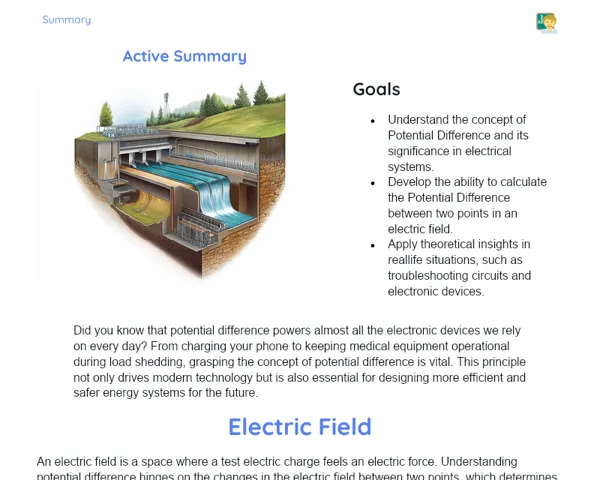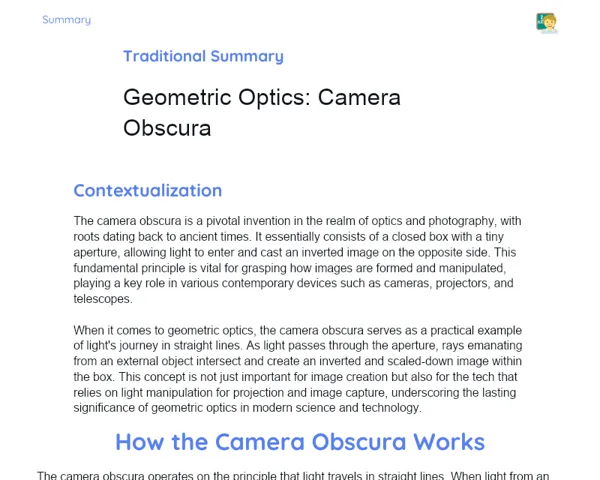Goals
1. Understand what kinetic energy is and how it connects with work.
2. Calculate the kinetic energy of an object using the appropriate formula.
3. Connect changes in kinetic energy to the work done on the object.
Contextualization
Kinetic energy is the energy that an object has because it’s in motion. We see this in our everyday lives – whether it's when we ride a bike, drive a car, or throw a ball. By learning how to calculate and measure kinetic energy, we gain insights into the workings of machines, vehicles, and natural forces like rivers and wind. This knowledge is crucial, especially in fields like transport systems, automotive design, and even in enhancing athletes' performance.
Subject Relevance
To Remember!
Understanding Kinetic Energy
Kinetic energy is the energy an object has because it's moving. This kind of energy is influenced by both the mass of the object and its speed. The heavier or faster the object, the more kinetic energy it has.
-
Kinetic energy is linked to motion.
-
It depends on both the object's mass and its speed.
-
To calculate it, we use the formula: (mass * speed^2) / 2.
Kinetic Energy Formula
The formula to find an object's kinetic energy (KE) is KE = (mass * speed^2) / 2. This shows us that kinetic energy increases with the square of the speed, meaning that even a slight boost in speed can lead to a significant increase in kinetic energy.
-
The formula is KE = (mass * speed^2) / 2.
-
Kinetic energy grows with the square of the speed.
-
Small speed changes can greatly affect kinetic energy.
Change in Kinetic Energy and Work
A change in an object's kinetic energy is linked directly to the work carried out on it. Work is the energy that is transferred into or out of an object through a force that causes it to move. When work is done on an object, its kinetic energy will change.
-
Work is the energy transferred to or from an object.
-
The change in kinetic energy is equal to the work done.
-
Work can either increase or decrease an object's kinetic energy.
Practical Applications
-
Automotive Engineering: Finding the kinetic energy of vehicles for better braking systems.
-
Aerospace Industry: Understanding the speed required for rockets to escape Earth's pull.
-
Sports: Enhancing athletes' performances in javelin or high jump events by applying kinetic energy principles.
Key Terms
-
Kinetic Energy: The energy that an object has due to its motion.
-
Kinetic Energy Formula: KE = (mass * speed^2) / 2.
-
Work: Energy that’s transferred to or from an object through a force that causes movement.
Questions for Reflections
-
How does understanding kinetic energy assist engineers in creating safer and more efficient vehicles?
-
In what ways can variations in kinetic energy affect the safety of transport systems?
-
Which other professionals, apart from engineers and athletes, could benefit from knowledge of kinetic energy?
Practical Challenge: Measuring Kinetic Energy
Put your understanding of kinetic energy to the test with a straightforward practical experiment you can do at home or in class.
Instructions
-
Find a safe small object to drop from a height, like a rubber ball or an empty drink can.
-
Weigh the object on a scale to get its mass.
-
Use a tape measure to find out the height from which you'll drop the object.
-
Drop the object from the measured height and use a stopwatch to time how long it takes to reach the ground.
-
Calculate the average speed of the object using the formula: speed = height / time.
-
Apply the kinetic energy formula (mass * speed^2) / 2 to find the kinetic energy of the object in motion.
-
Compare your results with those of classmates who did the same experiment.



